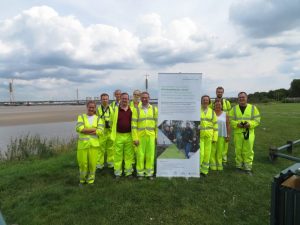 Last month, colleagues from the Ecosystems and Environment Research Centre (EERC) in the School of Environment & Life Sciences visited the new Mersey Gateway Crossing between Widnes and Runcorn.
Last month, colleagues from the Ecosystems and Environment Research Centre (EERC) in the School of Environment & Life Sciences visited the new Mersey Gateway Crossing between Widnes and Runcorn.
As part of our ICZ partnership with the Mersey Gateway Environmental Trust (MGET), the area around the new toll bridge will be a ‘living laboratory’ to monitor saltmarsh changes and effects on grazing cattle.
Professor Philip James, Leader of the EERC said: “For over a decade now we have been working in the Upper Mersey Estuary. Four PhD projects have been successfully completed and three more are currently underway, two of which are supported by i-Case funding.
“One of the aims of the visit was to agree the location for a 5km x1km RAPELD module, the first site in the UK to be part of the international Programa de Pesquisa em Biodiversidade (PPBio). This will offer University of Salford students excellent opportunities to carry out biodiversity surveys and contribute to an international biodiversity monitoring programme.”
The team was given a tour of the insides of the bridge, something that won’t be possible once it’s operational in the next few months. They were also able to take a lift to the top of the north tower from which they were able to see the Upper Mersey Estuary and begin locating the sampling points for the monitoring programme. They then visited various parts of the estuary at ground level to examine the sites in greater detail.
Paul Oldfield from the Mersey Gateway Environmental Trust said: “We would not be able to do this without the support of the University of Salford. Becoming part of an international programme exceeds our expectations of where we thought we would be at this stage of our development.”
